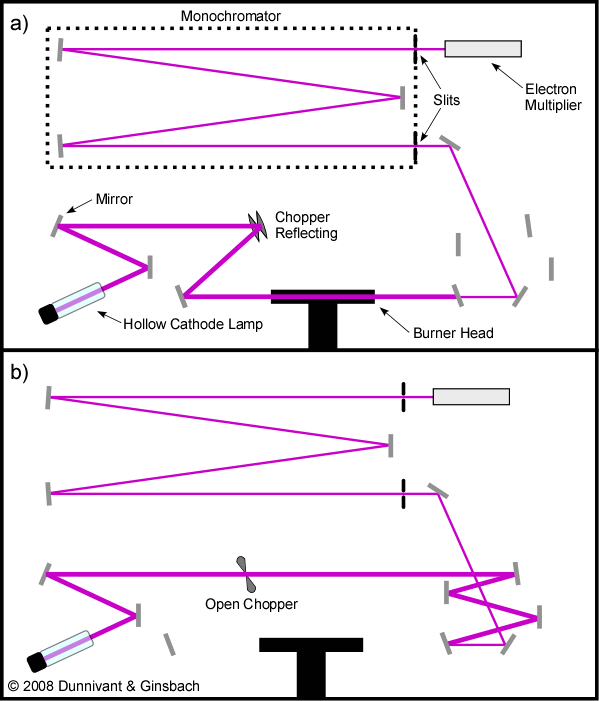2.2 Components of a Flame Atomic Absorption/Emission Spectrometer System
2.2.1 Overview
The general layout of optical components for a flame atomic absorption and emission spectrophotometer is shown in Figure 2-1. In FAAS, a source of pure light is needed to excite the analytes without causing excessive instrumental noise. Most instruments today use a hollow cathode lamp that is specific to each element being analyzed to emit a very narrow bandwidth of UV or visible radiation into the instrument for detection. All modern and some older atomic absorption systems use double-beam technology where the instrument splits the beam of source light, with respect to time, into two paths. One of these beams does not pass through the sample and is used to measure radiation intensity and fluctuations in the lamp, while the other beam is used to measure the radiation that interacts with the analyte. The splitting of the source beam is accomplished with a chopper, illustrated in Figure 2-2 where the chopper is in the reflection position in the center of the figure. The other half of the time, radiation is passed through the sample cell: in this case, the flame that contains the atomized gaseous metal analytes. A portion of the metal atoms absorbs a specific wavelength of radiation (matching the wavelength emitted by the hollow cathode lamp) that results in a quantitative reduction in the intensity of radiation leaving the sample cell. After interaction with the sample, or in the case of the reference beam bypassing the sample in the burner head, the beam of light is reflected by mirrors into the monochromator. This reflected light that contains various wavelengths past through a small slit that is size adjustable. Then it reflects off a focusing mirror to travel to the dispersing device (today a grating monochromator is used). Finally, the separated wavelengths of light are focused towards the exit slit with another focusing mirror. By changing the angle of the monochromator, different wavelengths of light enter the detector through the exit slit of the monochromator. The detector in most AAS units is a photoelectron multiplier tube (PMT) that amplifies and converts the signal of photons to electrons that are measured as an electrical current.
An emission spectrometer can be identical to an absorption system except that no external light source is used to excite the atoms. In flame emission spectroscopy, the electrons in the analyte atoms are excited by the thermal energy in the flame. Thus the sample is the source of photon emissions through relaxation via resonance fluorescence (Section 1.2.2). Note that this results in emission systems that are only single beam in design.

Figure 2-1. An Overview of a Flame Atomic Spectrophotometer. a) in detection mode where the source beam goes through the flame sample cell; b) in reference mode where the source beam bypasses the sample cell.
One modern and very important component not shown in Figure 2-1 is an automatic sampler. An automatic sampler is a device that is used to analyze numerous samples without the constant attention of an analyst. Modern automatic samplers can hold over a hundred samples. They can be used for most of the modes of FAAS and FAES. Instrument setup for running a set of samples with an automatic sampler is similar to the normal instrument setup: the correct lamp must be installed and aligned and the flame must be lit and optimized with respect to burner height. Software and instrument settings may also need to be adjusted to ensure a smooth run of samples. Of course, automatic samplers require the use of a computer to both run the automatic sampler and collect the relatively large amount of data produced from various samples. Automatic samplers greatly reduce the cost of analysis when large numbers of sample need to be analyzed for the same element. Usually an analyst will spend a normal day shift processing (digesting and diluting) samples. An instrument equipped with an automatic sampler can be set up at the end of the day and allowed to run all night without paying an analyst to manually run the samples or “baby sit” the instrument. In the morning, the analyst arrives with a collection of data to process.
| Frank's Homepage |
©Dunnivant & Ginsbach, 2008